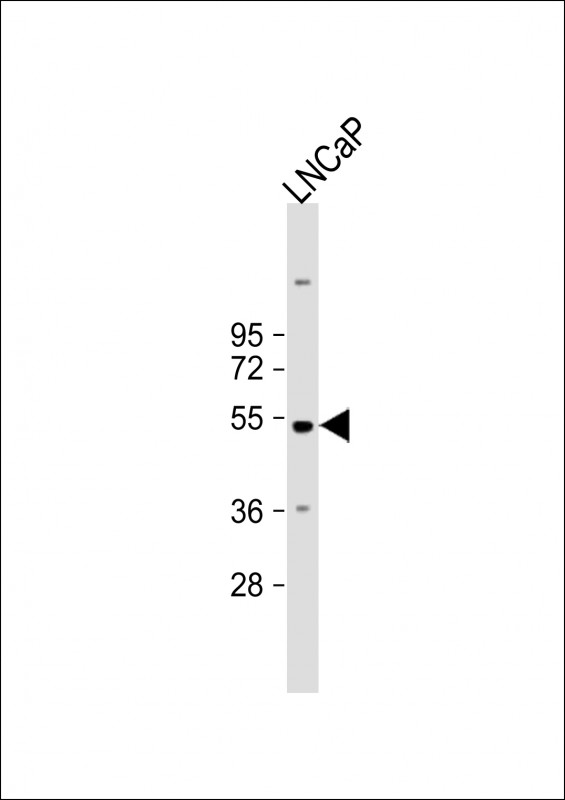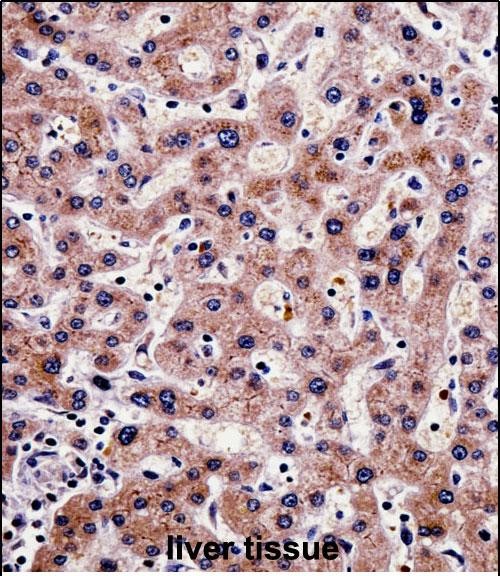


| WB | 1/1000 | Human,Mouse,Rat |
| IF | 咨询技术 | Human,Mouse,Rat |
| IHC | 1/100-1/500 | Human,Mouse,Rat |
| ICC | 技术咨询 | Human,Mouse,Rat |
| FCM | 咨询技术 | Human,Mouse,Rat |
| Elisa | 咨询技术 | Human,Mouse,Rat |
| Aliases | Serine hydroxymethyltransferase, cytosolic, SHMT, Glycine hydroxymethyltransferase, Serine methylase, SHMT1 |
| Entrez GeneID | 6470 |
| WB Predicted band size | 53.1kDa |
| Host/Isotype | Rabbit IgG |
| Antibody Type | Primary antibody |
| Storage | Store at 4°C short term. Aliquot and store at -20°C long term. Avoid freeze/thaw cycles. |
| Species Reactivity | Human |
| Immunogen | This SHMT1 antibody is generated from rabbits immunized with a KLH conjugated synthetic peptide between 19-47 amino acids from the N-terminal region of human SHMT1. |
| Formulation | Purified antibody in PBS with 0.05% sodium azide. |
+ +
以下是关于SHMT1 (N-term)抗体的3篇参考文献,包含文献名称、作者及摘要内容概括:
---
1. **"Serine hydroxymethyltransferase 1 regulates mitochondrial folate metabolism in cancer cells"**
*作者:Kim D, et al. (2016)*
**摘要**:研究利用SHMT1 (N-term)抗体通过免疫印迹和免疫荧光实验,验证SHMT1在线粒体中的定位及在肿瘤细胞叶酸代谢中的功能,发现其缺失影响核苷酸合成与肿瘤增殖。
2. **"SHMT1 knockdown induces apoptosis in lung adenocarcinoma via oxidative stress and DNA damage"**
*作者:Zhang Y, et al. (2018)*
**摘要**:通过SHMT1 (N-term)抗体的Western blot分析,证实SHMT1在肺癌细胞中的表达水平与其抗凋亡作用相关,敲低SHMT1导致活性氧积累和基因组不稳定。
3. **"A functional variant in SHMT1 predicts colorectal cancer survival"**
*作者:Liu X, et al. (2020)*
**摘要**:采用SHMT1 (N-term)抗体进行免疫组化分析,发现结直肠癌组织中SHMT1高表达与患者预后不良显著相关,提示其作为潜在生物标志物的价值。
---
以上文献均明确使用N端特异性SHMT1抗体进行实验验证,涵盖肿瘤代谢、凋亡机制及临床预后研究。如需具体抗体货号或实验细节,可进一步查阅原文方法部分。
The SHMT1 (N-term) antibody is designed to target the N-terminal region of serine hydroxymethyltransferase 1 (SHMT1), a key enzyme in folate-mediated one-carbon metabolism. SHMT1 catalyzes the reversible conversion of serine and tetrahydrofolate (THF) to glycine and 5.10-methylene-THF, a reaction critical for nucleotide synthesis, methylation, and cellular redox balance. It exists in cytosolic and mitochondrial isoforms (SHMT1 and SHMT2. respectively), with SHMT1 primarily localized to the cytoplasm. This enzyme plays a role in development, cell proliferation, and cancer progression, as dysregulation is linked to tumor growth and chemoresistance.
The SHMT1 (N-term) antibody is commonly used in research to detect endogenous SHMT1 protein levels via techniques like Western blotting, immunohistochemistry, or immunofluorescence. Its specificity for the N-terminal region ensures recognition of full-length SHMT1 while minimizing cross-reactivity with other isoforms or truncated variants. Researchers employ this antibody to study SHMT1 expression patterns in diseases such as cancer, where SHMT1 overexpression is associated with poor prognosis, or in metabolic disorders linked to folate deficiency. Validated applications and species reactivity (e.g., human, mouse, rat) vary by commercial source, and proper controls are essential to confirm target specificity.
×